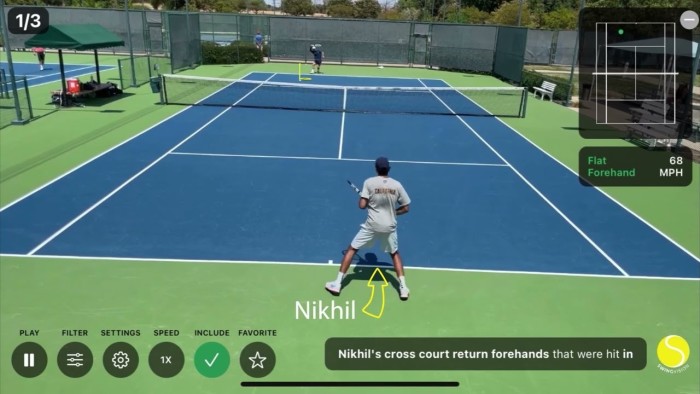Unlock the Editor’s Digest for free
Roula Khalaf, Editor of the FT, selects her favourite stories in this weekly newsletter.
Tennis has long been associated with affluence and exclusivity. But this reputation is looking increasingly outdated, with barriers to entry falling as the sport’s infrastructure develops. Now software engineers and entrepreneurs are making the game even more accessible, with a growing range of apps and gadgets offering recreational players the kind of benefits that were once limited to professionals and clubs.
SwingVision
If you have ever wondered how your playing statistics might compare with those of the pros, this is the app for you. The brainchild of a former Tesla Autopilot engineer and a former software developer at networking site LinkedIn, SwingVision provides real-time shot tracking, video analysis and officiating using just your phone.
After filming your game from the back of the court, the app provides a condensed video of all shots, with gaps between points erased, as well as a huge range of statistics, from serve speed and forehand winners to errors and shot placement maps.
While it can be a little alarming to be confronted with video of your technique, it is useful to have evidence of where you are going wrong. SwingVision, which can also be used as an in-game line judge, has been downloaded more than 1mn times. It is only available on Apple devices but Android compatibility is in the works. (£14.99/$14.99 a month, swing.vision)
TopSpin Pro
The art of topspin is essential to developing your game, allowing players to hit harder without the ball flying out of court, but it is a notoriously difficult skill to learn. This training aid can save hours’ worth of coaching fees.
Launched a decade ago by South African entrepreneur and tennis coach Phillip Hofmeyr with the help of a Kickstarter crowdfunding campaign, the device consists of a ball on a spring-mounted spindle that sits in front of a tilted screen.
The idea is for players to perfect the upward “windscreen wiper” racket motion that gets the ball spinning, with the screen ensuring the head is kept at the optimum downward angle. Repeating the process allows rapid mastery of the technique, locking it into the muscle memory for later deployment on court.
The company has sold more than 130,000 units to customers in 125 countries, and says the device has helped more than 1mn players learn topspin. (£129, www.topspinpro.com)
Topspin Pro

Saber

Saber
The principle of the Saber is to make tennis more difficult during training so the real thing becomes easier later on. Developed by Irish entrepreneur and tennis podcaster Fabio Molle, the product is like a regular racket in all but one respect — the size of its head.
The 37 square inch face is little more than a third the size of most modern rackets’ heads, so it requires much greater accuracy when striking the ball, and makes it easier to hit from the “sweet spot” when you return to your normal racket.
The Saber, which has been spotted in use by senior professionals, is the same weight and length as a normal racket. (£129/$175/€149.95, functionaltennis.com)
Player-matching apps
One of the biggest challenges for the casual tennis player is finding someone to hit with. The era of the app has made the process much more painless, with a plethora of platforms making it easier to find a partner.
Each one’s usefulness depends on uptake in your specific area, but what was once an overcrowded market has now settled, with clear winners in certain regions — RacketPal and Spin are the strongest options in the UK.
They all work in a similar way — sign up, enter your age and skill level, find someone similar and arrange a game. Many also allow you to organise leagues or other contests.
Player-matching apps

Spinfire Pro 2

Spinfire Pro 2
Until recently the preserve of well-resourced clubs, ball machines have shrunk in size and cost, and the Spinfire Pro 2 is among the best of a clutch of recent market entrants. With a hopper capacity of 150 balls, it can send over all sorts of shots, from deep, fast topspin right to the baseline to backspin drop shots.
An app — or a tiny remote control — allows in-play changes to the ball speed, trajectory, spin and angle, as well as the interval between shots. You can also set up drills. Although a hefty 20kg, it has two large wheels and a pullout handle for easy transportation.
It is expensive — but if you are paying a coach just for hitting practice, it could save money in the long run. (From £2,150, www.spinfiresport.com)
FT Scoreboard

Scoreboard is the FT’s weekly briefing on the business of sport. Sign up at ft.com/scoreboard
